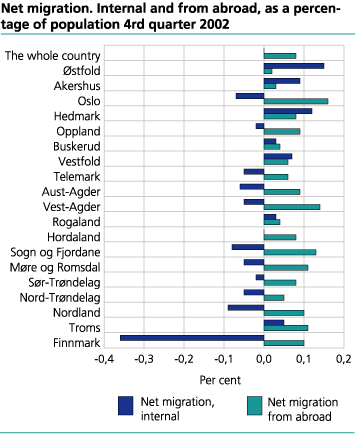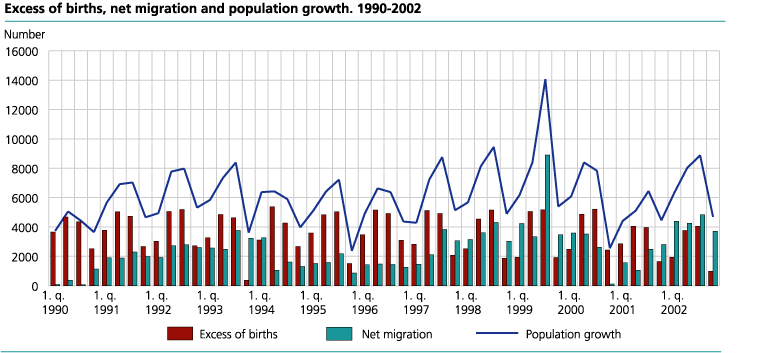Content
Published:
This is an archived release.
Population growth due to immigration
Net migration in Norway increased last year, from 8 000 in 2001 to 17 200 in 2002. The net immigration to Norway has only been higher in 1999. At the end of the year about 4 552 000 people were living in Norway.
In 2002 the population increased by 27 900, or 6 per thousand. This is the highest increase in Norway for the last 30 years, with the exception of 1998 and 1999. Population growth is caused by increased net migration of 17 200, and natural increase of 10 700, according to preliminary figures.
Immigration secures population growth
44 700 persons died in Norway in 2002, this is an increase of 700 from 2001, and the number of live births decreased to 55 400. In the same period there were about 6 000 more immigrants and 3 500 less emigrants. Estimated numbers from 2002 show that a total of 40 100 persons moved to Norway and 22 900 persons moved from the country. A consequence was a positive net migration of 17 200 persons, turning the negative trend of the last two years.
Among Norwegian citizens there was a negative net immigration of 1 400 persons, slightly less than previous years. The last years approximately 10 000 Norwegian citizens have moved to and from Norway each year.
The increase of immigrants to Norway in 2002 could be related to the shorter time the Norwegian Directorate of Immigration uses to treat the individual applications of residency, especially for family reunion.
More european immigrants
Net migration of European citizens, excluded Norwegians, has increased from 2 100 in 2001 to 6 000 in 2002. Of these, 3 800 are form Eastern Europe, 1 400 from Western Europe (excluded the Nordic countries) and 800 from the Nordic countries.
Germany (700), Denmark (400) and Great Britain (300) were the biggest groups form Western Europe. Russia (1 200), Poland (600) and Turkey (500) were the biggest groups from Eastern Europe. The number of Swedish citizens moving from Norway and to Norway was the same, 2 900.
More Iraqis, Afghans and Thais
Net migration of Asiatic citizens was 8 000, 2 500 more than last year. Iraqis (2 400), Afghans (1 100) and Thais (900) were the biggest groups. Before 1999 there were not many Afghanis in Norway. From Africa there was still a majority of Somalis (2 000).
Compared to other European countries
Norway has a relatively high natural increase, net migration and population growth compared with the countries in the EU, according to first estimates from Eurostat . While the expected population growth in Norway is 6 per thousand, it is 3,5 in the European Union. In EU countries only Ireland and Luxembourg have higher expected growth than Norway. Of the 10 accending countries only Cyprus and Malta have higher growth than the average in the EU. All the accending countries from Eastern Europe except Slovenia have declining population, especially the Czech Republic. Only Ireland, France, Luxembourg and Netherlands have higher natural increase than Norway. And only Portugal, Luxembourg, Spain and Ireland have higher net migration.
The statistics is published with Population.
Contact
-
Statistics Norway's Information Centre
E-mail: informasjon@ssb.no
tel.: (+47) 21 09 46 42


